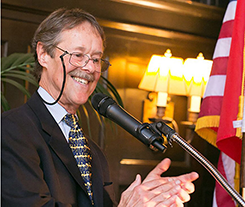
By Mel Gurtov
Oct 18, 2025
 |
|
| Mel Gurtov |
Separating the Practical from the Ideal
Intractable conflicts are wars without end, and Russia’s war with Ukraine seems to fit the bill. Now three and a half years old, the war goes on without any sign of a letup in the violence. Neither side seems willing to give an inch; both sides seem either to believe in ultimate victory or to find insufficient incentives to stop fighting.
To the contrary, their outside supporters continue to provide weapons and military supplies that ensure more destruction and casualties. Russian bombardments are focusing on major Ukraine energy facilities, and Russia is conducting “hybrid warfare” that includes jet and drone crossings of NATO country territory. The Trump administration said it was considering supplying Ukraine with Tomahawk long-range missiles, which Russia has warned would be a serious escalation. No one has offered a well-reasoned peace plan or threatened sanctions severe enough to cause strategic rethinking in Moscow or Kyiv.
Now President Trump is scheduled to meet with Vladimir Putin in Budapest, following a meeting of Trump and Volodymyr Zelensky in Washington. After a phone conversation with Putin, Trump is back to believing that Putin “wants to end the war.” That might quash the Tomahawk deal, but will it resurrect the cease-fire idea?
Let’s not wait to find out. Instead, let’s consider what might halt—not settle, but halt—this war. To clarify, I’m not aiming at what is fair or just, but about what might be acceptable to both sides as an alternative to continued warfare. In a just world, Ukraine, as the victim of Russian aggression, should be compensated by Russia for its human and material losses and Russia’s leaders should be prosecuted for war crimes.
But we live in a world in which aggression often pays and justice is subject to political bargaining. Thus, the challenge is to imagine incentives that will cause Russian and Ukraine leaders to decide that negotiating is better than fighting, and that painful concessions to the other side are outweighed by the rewards.
Outline of an Agreement
First, Ukraine and Russia accept a cease-fire overseen by a UN peacekeeping operation. The peacekeeping force will monitor the agreement. It may only be withdrawn with the consent of both parties.
Second, Russia will withdraw all military and paramilitary forces that are operating in internationally recognized Ukrainian territory, except for Crimea.
Third, Ukraine, as well as the US and the European Union, accept Russia’s occupation of Crimea as a political reality but will not legally recognize it.
Fourth, the US and NATO agree that Ukraine will not become a member of NATO so long as Russia withdraws its forces and abides by a pledge of noninterference in Ukraine’s affairs.
Fifth, the US and NATO agree not to station military units in Ukraine, including training units. But all countries may supply Ukraine with weapons and other military assistance for self-defense.
Sixth, the European Union, the US, the UN, and other interested parties agree to provide funds for Ukraine’s rebuilding. The EU will release the approximately $300 billion in frozen Russian state assets as “loans” to Ukraine. If Russia agrees to reparations for Ukraine, the unfrozen funds will be reduced by that amount.
Seventh, the US and the EU agree not to prosecute Russian officials for violations of international law and UN conventions, subject to Russian adherence to this agreement.
Eighth, the US and the EU agree to gradually remove economic sanctions on Russia and restore normal trade and investment relations, subject to Russia’s adherence to this agreement.
Ninth, Russia will return all children and other persons forcibly taken from Ukraine. Ukraine and Russia will exchange all prisoners.
Tenth, Ukraine and Russia agree that within one year of implementation of this agreement, negotiations will begin toward a peace settlement to end the war.
Further Thoughts
Why would Vladimir Putin or Volodymyr Zelensky accept such an agreement? After all, Russia gives up occupied land and military leverage on Ukraine’s ability to remain a viable country, while Ukraine yields its claim to Crimea and its hope to join NATO.
But the incentives for each to accept the agreement are substantial. For Putin, those are resumption of trade and investment relations with the West at a time of economic difficulties, acceptance of Crimea as part of Russia, dismissal of war crimes charges against him and his top officials, and assurance that Ukraine will not become a NATO member.
For Zelensky, the agreement promises an end to Ukraine’s horrific losses of life and economic assets, the start of rebuilding with outside aid, restoration of its eastern territories occupied by Russia, UN monitoring of Ukraine’s borders, return of the kidnapped children, and the promise of defense assistance.
For all that, this agreement almost inevitably has loopholes—opportunities for both sides “legally” to violate its spirit. Most importantly, the agreement cannot guarantee that fighting will not resume inside Ukrainian territory in violation of the cease-fire, with neither side taking responsibility.
Nevertheless, in the best of circumstances, an agreement along the above lines should significantly end military operations, stop the bloodshed, and start Ukraine’s healing process. The agreement will not “resolve” the war; that can only happen either when one side essentially surrenders (as Hamas may be doing now) or when both sides decide that further fighting is futile. The latter situation seems more likely, and once it comes about, an agreement on terms to halt the fighting will become mutually compelling. Peace will come, however, only when a cease-fire holds for some time.
Mel Gurtov, syndicated by PeaceVoice, is Professor Emeritus of Political Science at Portland State University.
